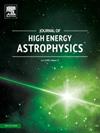Long pulse by short central engine: Prompt emission from expanding dissipation rings in the jet front of gamma-ray bursts
IF 10.5
4区 物理与天体物理
Q1 ASTRONOMY & ASTROPHYSICS
引用次数: 0
Abstract
Recent observations have challenged the long-held opinion that the duration of gamma-ray burst (GRB) prompt emission is determined by the activity epochs of the central engine. Specifically, the observations of GRB 230307A have revealed a different scenario in which the duration of the prompt emission is predominantly governed by the energy dissipation process following a brief initial energy injection from the central engine. In this paper, we explore a mechanism where the energy injection from the central engine initially causes turbulence in a small region and radiates locally. This turbulence then propagates to more distant regions and radiates. Consequently, the emission regions form concentric rings that extend outward. Using an idealized toy model, we show that such a mechanism, initiated by a pulsed energy injection, can produce a prompt emission light curve resembling a single broad pulse exhibiting the typical softer-wider/softer-later feature. Under some parameters, the main characteristics of the GRB 230307A spectra and light curves can be reproduced by the toy model.
由短中心引擎产生的长脉冲:伽马射线暴喷流前端膨胀耗散环的快速发射
最近的观测对长期以来的观点提出了挑战,即伽马射线暴(GRB)瞬发的持续时间是由中心引擎的活动时期决定的。具体来说,GRB 230307A的观测揭示了一种不同的情况,在这种情况下,快速发射的持续时间主要由中央发动机短暂的初始能量注入后的能量耗散过程决定。在本文中,我们探索了一种机制,从中央发动机的能量注入最初引起湍流在一个小区域和局部辐射。这种湍流然后传播到更远的区域并辐射。因此,发射区域形成向外延伸的同心环。利用一个理想化的玩具模型,我们展示了这样一个机制,由脉冲能量注入启动,可以产生一个类似于单个宽脉冲的快速发射光曲线,表现出典型的更宽/更软后的特征。在一定参数下,该模型可以再现GRB 230307A的主要光谱特征和光曲线。
本文章由计算机程序翻译,如有差异,请以英文原文为准。
求助全文
约1分钟内获得全文
求助全文
来源期刊

Journal of High Energy Astrophysics
Earth and Planetary Sciences-Space and Planetary Science
CiteScore
9.70
自引率
5.30%
发文量
38
审稿时长
65 days
期刊介绍:
The journal welcomes manuscripts on theoretical models, simulations, and observations of highly energetic astrophysical objects both in our Galaxy and beyond. Among those, black holes at all scales, neutron stars, pulsars and their nebula, binaries, novae and supernovae, their remnants, active galaxies, and clusters are just a few examples. The journal will consider research across the whole electromagnetic spectrum, as well as research using various messengers, such as gravitational waves or neutrinos. Effects of high-energy phenomena on cosmology and star-formation, results from dedicated surveys expanding the knowledge of extreme environments, and astrophysical implications of dark matter are also welcomed topics.
 求助内容:
求助内容: 应助结果提醒方式:
应助结果提醒方式:


